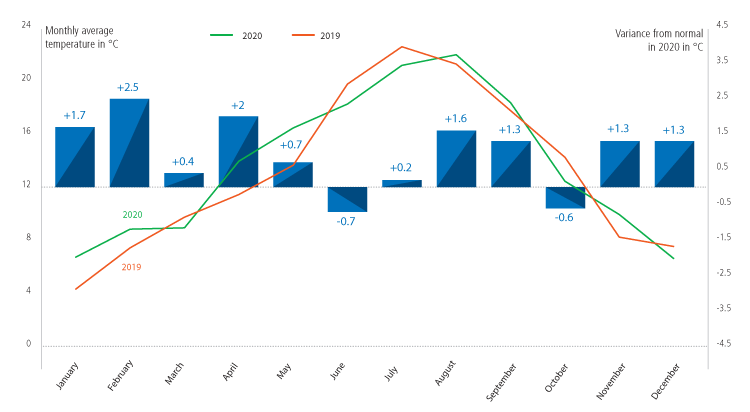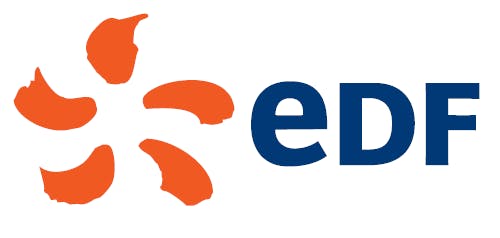5.1.2.3 Electricity and natural gas sales tariffs
In France, the regulated sales tariffs were raised:
- on 1 February 2020 by 2.4% (including taxes) for both residential customers and non-residential customers on the “blue” tariff;
- on 1 August 2020 by 1.54% (including taxes) for residential customers on the “blue” tariff and 1.58% (including taxes) for non-residential customers on the “blue” tariff.
In the United Kingdom, a cap on the variable tariffs for residential electricity and gas customers was introduced on 1 January 2019. This cap is updated every6 months to take account of cost revisions. It was reduced by 7% for the period 1 October 2020 to 31 March 2021 in order to reflect movements in wholesale market prices associated with the Covid-19 pandemic. In October, the British government announced that the cap would continue for at least a further twelve months, until the end of 2021.
5.1.2.4 Weather conditions: temperatures and rainfall
5.1.2.4.1 Temperatures in France
2020 was France’s warmest year on record since 1900, registering an annual temperature of 13.6 °C (the record was previously 13.4 °C, in 2018), 1 °C higher than normal and 0.5 °C higher than 2019.
February 2020 was the second-warmest month of February since 1980 (after
February 1990), and April and August 2020 the third-warmest (behind April 2007and April 2011, and August 1997 and August 2003).
Two weeks during the summer of 2020 registered temperatures 5° C above normal (6-12 August: +5.3 °C, and 13-20 September: +5.0 °C).
In October, after relatively cool temperatures until the 19th (2.1 °C below normal), the weather grew milder and stayed mild overall until the end of the year (an average +1.4 °C above normal, although there were several days with below-normal temperatures).
The middle of December (11-24) was particularly mild, with a peak on 22 December at +7.5 °C above normal.
Temperatures (1) (2) (3) in France in 2020 and 2019

Temperatures in 2019 vary on average between 4 ° C in January to 23 ° C in July.
The temperatures in 2020 follow the same evolution curve.
There are temperature deviations in 2020 from normal, ranging from -0.7 ° in June to + 1.6 ° in August.
(1) Average temperatures recorded in 32 cities, weighted by electricity consumption.
(2) Source: Miréor (data from Météo-France).
(3) Normal temperatures are applicable to the decade 2011-2020.
5.1.2.4.2 Rainfall
In 2020, rainfall in Europe was characterised by:
- a first half-year with normal precipitation over much of Europe, except for Scandinavia where above-normal rainfall was recorded and Italy where there was a shortage of rain;
- a second half-year that began with a very dry summer, followed by a wetter autumn. As a result rainfall remained above normal in Scandinavia, and became above normal in the United Kingdom and Central Europe.
In France, rainfall in 2020 was close to normal levels at national and annual level, but there were sharp regional contrasts. The wettest months were February, June, October and December, while April, July and November were very dry. There was a notably hot, dry summer in the north-east quarter of France, leading to severely low water levels in that zone.
Snow fell early on the French Alps and the Pyrénées, and snow levels were generally above normal until the end of the winter in the French Alps and closer to normal overall in Pyrénées and in the Rhine region. The mid-height mountains (below 1,600m) had below-normal snow levels due to abnormally high temperatures in the winter of 2019-20. The snowcap began to melt early, from mid-March, in all mountain areas.
As a consequence of these hydrometeorological conditions, annual water flow coefficients in France were slightly above normal in 2020, by about 3%. Nonetheless there were marked disparities between different areas and periods. In the plains and the Massif Central mountains water levels were often below normal or significantly below normal, while the Alps and the Pyrénées often had above-normal levels.
